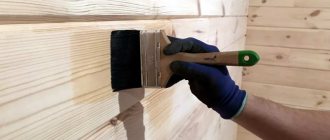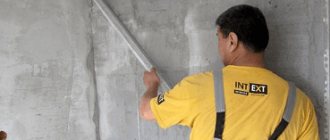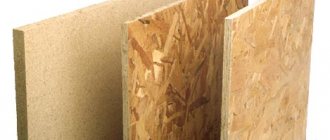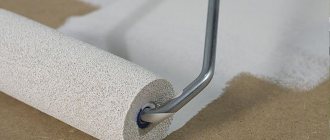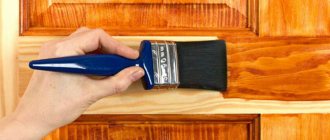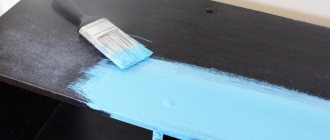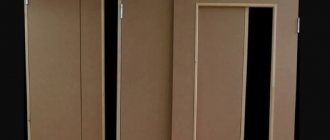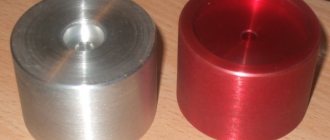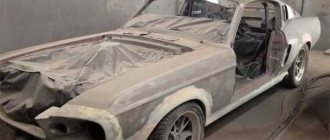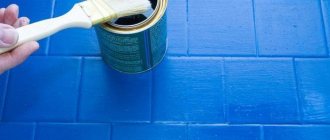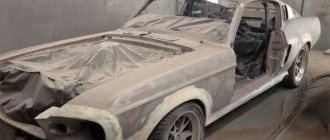Maksym
12188 0 2
Maksym June 14, 2017 Specialization: country construction, apartment renovation, landscaping of a personal plot, installation and connection of utilities.
In order for the paint to lay evenly on the fiberboard, the surface must first be primed.
Do you use wood fiber boards (DFB) in your work and don’t know how to paint them correctly? In order for the paint to lay down in an even layer, preliminary preparation of the surface of the material is required. I'll tell you how you can quickly cope with this task with your own hands.
Advantages and disadvantages of fiberboard
The boards consist of fibers, pressed shavings, sawdust and other wood waste. When making fiberboard, resins of synthetic origin, antiseptics, fungicides and additives (paraffin, rosin) are added to it. With the help of these components, the slab becomes moisture resistant.
- low price;
- strength;
- resistance to moisture, which is provided by the additives included in the composition;
- durability, wear resistance. The sheets are coated with protective impregnations that prevent mold and insects.
But fiber board has disadvantages:
- painting and processing are done only on one side;
- sheets are not used in load-bearing structures.
Advantages of fiberboard
As a result of pressing waste from the woodworking industry at high temperatures, smooth and easy-to-process sheets are obtained, which are used both for the manufacture of furniture and for cladding walls and floors. Among the positive qualities of this material it is worth noting:
Fiberboard structure
- High strength . Material marked “ST” is used in industry for cladding floors, walls of carriages, in furniture production and others.
- Low price category. Due to the fact that the production of the material involves the use of any sawmill and woodworking waste with the addition of synthetic resins, antiseptics and other stabilizing substances, its cost is much competitive compared to other types of boards.
- Moisture resistance . With proper priming and painting, hardboard can easily withstand moisture.
- Durability . During manufacturing, the material is coated with a special impregnation that is not susceptible to the formation of fungi or insect pests. Thanks to this, the material will remain in its original condition for a long time.
To preserve all these properties, the material should be properly processed before installation. Let's look at how to do this point by point.
Selection of materials for painting
To work with slabs, use wear-resistant paint only for wood.
Types of compositions suitable for painting fiberboard
- Oil and alkyd enamel. These are wear-resistant coloring materials containing natural or synthetic drying oil. More often, a coating is used that was made on the basis of pentaphthalic drying oil or alkyd resins (PF-226 enamel).
- Acrylic paint with increased wear resistance based on water dispersions. This material is more expensive. It is used for treating floors in living rooms.
- Compositions based on epoxides and alkyd-urethanes. They are a set of two components that are prepared for work, taking into account the service life of the mixtures.
When selecting a suitable composition, it is worth remembering that fiberboard is a cheap material compared to other floor coverings. Therefore, it would be illogical to use expensive mixtures for painting it. Paint and varnish materials must be inexpensive and durable.
An excellent option would be oil-based enamel paint with a hard, wear-resistant base marked “ST”. You can also use decorative or bitumen varnish. When using such materials, they create the illusion of a wood pattern or make the surface glossy.
Water-based paints should not be used to paint fiber sheets. It will not adhere to the surface of the slab, since it is impregnated with paraffin, which protects the pressed sheets from moisture.
When painting a fiberboard ceiling, preference is given to water-soluble materials with the effect of ordinary whitewash.
To achieve the best look, you should carefully hide all seams in the sheets.
Before applying the composition, the surface is degreased with alcohol or products containing this component.
In order to paint a door made of pressed sheets, it is worth considering the following nuances:
- the door is removed from its hinges and placed outside, placed on chairs;
- then painted with the selected composition;
- The fittings are protected from paint splashes with foil or film.
Since doors are subject to less mechanical stress and are an interior detail, preference is given to expensive painting materials that dry quickly and have a rich range of colors.
Preparing for work
In order to paint fiberboard with high quality with your own hands, you need to carefully prepare for work and assemble equipment before painting. For this you will need:
- roller with fur cover;
- small brush for processing small parts and hard-to-reach areas;
- paint tray;
- spatula for grouting joints between fiber boards;
- vacuum cleaner for cleaning hardboard from dust after sanding and other contaminants.
Choosing a primer for chipboards and features of its application
The choice of primer depends on many factors, one of which is the location of the surface to be treated:
- In a dry room, you can use any primer designed for wood.
- A damp environment, such as a bathroom, requires a moisture-resistant primer that contains ingredients that resist mildew and mildew. Deep penetration soil is suitable. It will help prevent the slabs from swelling from moisture.
- To cover slabs located outdoors, a wood primer for exterior use is suitable. It will protect the chipboard from UV radiation, moisture and temperature changes. It should contain an antiseptic that resists the formation of rot.
Primer for chipboard should not react chemically with:
- wallpaper glue;
- tile adhesive;
- decorative coating.
Choosing a primer for particle boards
Types of primer
Before painting the fiberboard, it is primed. The paint adheres better to the treated sheet and its consumption is reduced. Since wood boards have different surfaces, different compositions are selected for the front and back sides.
- Alkyd primer forms a protective layer on the surface of the slab in the form of a matte film, onto which paint adheres well. The solution increases the service life of the material and does not contain toxic substances. It dries for 24 hours at a temperature of +20 C. The solution is used to treat the front and inner parts of the sheet.
- Drying oil is a natural product that penetrates deeply into the material and forms a dense glossy layer. The treated surface interacts well with oil paint. Drying oil protects the material from moisture penetration. The disadvantages of drying oil are that it takes a long time to dry, has a specific smell, and the room must be well ventilated when working. Used for processing fiberboard on both sides.
- Water-based acrylic primer is odorless as it does not contain toxic elements. It is easily applied to the surface with a roller and dries for three hours at room temperature. However, the product has an important drawback: the material strongly absorbs the water base. Apply acrylic solution to the front side of the slab.
- Acrylic latex based primer. The product contains fungicides and insecticides, substances that prevent the formation of fungus. Odorless acrylic latex primer, apply it to the sheet in one layer. The product is used for priming on both sides of the panel.
What primer is needed for fiberboard - preparing the surface for finishing
In order for the paint to lay evenly on the fiberboard, the surface must first be primed.
Do you use wood fiber boards (DFB) in your work and don’t know how to paint them correctly? In order for the paint to lay down in an even layer, preliminary preparation of the surface of the material is required. I'll tell you how you can quickly cope with this task with your own hands.
What products do not go well with hardboard?
Of the products that are used to process wood fiber boards, acrylic primer has the worst performance. Because it is made on a water basis, and water is the main enemy of hardboard.
The front side of the slab is smooth, as the coating contains paraffin and rosin. Additives repel water and prevent it from saturating the material. To prime the products I use a deep penetration acrylic primer.
The back surface of the sheet is porous and, unlike the front, therefore strongly absorbs moisture. To paint fiberboard without gaps, it needs to be primed several times, this leads to overspending. Also, the treated sheets must be dried under a press so that the wet sheet does not lose its shape.
The best indicators are to prepare the surface for painting using drying oil. The product ensures good adhesion of the surface to the paint and protects the material from moisture. It is easy to apply on a plane, the price of the product is not high.
Production and use of fibreboards
Please note that the prices in the article are current in spring 2017.
Fiberboard has another common name - hardboard. Such boards are made from softened small wood fibers:
- The moistened wood pulp is compressed into thin sheets under high pressure and then dried at a temperature of 80-120° C;
- The dried sheets are cut to the required size on a machine and packed into pallets for shipment to consumers.
Front (smooth) and back (rough) sides of hardboard sheets.
Due to its mass availability and low cost, this material has a wide range of applications in various fields:
- Manufacturing of back walls and filling of hidden cavities in the production of upholstered and cabinet furniture;
- Leveling and thermal insulation of plank subfloors under the finished floor covering;
- Covering wooden frames of built-in furniture and light interior partitions;
- Interior finishing of ceilings, floors and walls in utility rooms and utility rooms;
- Production of a rigid base for artistic painting, painting pictures and other interior design details.
Due to the porous structure of the material, the primer penetrates deeply between the wood fibers.
Technical features of the material
Fiberboards are produced in sheets of various sizes with a thickness of 3.2-4.5 mm. On the front side, the fiberboard has a smooth surface with a dense glossy outer layer. The back side, on the contrary, has a very rough surface, so the sheets are always attached with the front side facing out.
The table describes the positive and negative qualities of fiberboard sheets:
| Advantages | Flaws |
|
|
How to prime hardboard with drying oil
The fiberboard structure is porous and absorbs a large amount of paint, so before painting you need to prime the surface:
- Before priming the hardboard and fiberboard, the drying oil is heated to +40 C - 50 C; the PF brand is used for work. It is not recommended to use a product at home that contains petroleum-polymer resin, as well as compositions with rosin suspension. This drying oil is toxic and takes a long time to dry.
- The surface of the slab is cleared of debris. The gaps at the joints of the sheets are sealed with tape or reinforced tape. The entire area is degreased using alcohol or a solvent (white spirit or acetone based). You need to pay attention to the ends of the sheet; these places are often forgotten to be worked on.
- Fiberboard is primed in 2-3 layers to better saturate the material.
- Apply the primer each subsequent time after complete drying.
- The soil for fiberboard is selected taking into account which part of the sheet will be processed. They also take into account what kind of paint the surface will be painted with. Drying oil, acrylic, which is water-based and most unsuitable for working with fiberboard, has proven itself to be the best.
A fiberboard ceiling is a simple solution that saves a lot of hassle. The main ones are that the fiberboard surface does not need to be plastered and leveled. All that remains is the finishing touches.
If you are just thinking about installing a fiberboard ceiling, it makes sense to pay attention to laminated panels. They are already finished - one side is laminated. Moreover, the palette is quite wide - although fiberboard panels are often used to decorate walls, it is also easy to choose for ceilings.
Palette of fiberboard panels for the ceiling
painted fiberboard panel sheets
If ordinary panels are attached to the ceiling, then, of course, the question arises about painting them. How to paint a fiberboard ceiling to get a full, durable and beautiful coating?
Laminated fibreboard
Laminated fibreboard
In addition to such unpredictable solutions, there are also simpler solutions. Currently, laminated fiberboard sheets have begun to appear on the market, which do not require additional processing and painting. When using this type of coating, you should take a more responsible approach to aligning joints and sealing them. And after flooring, it is still recommended to cover them with parquet varnish.
It is recommended to attach laminated hardboard to the floor not with nails but with glue.
How to putty fiberboard before painting
One slab for the ceiling is not enough, so you can’t do without puttying the joints. The process is simple: the seams are filled with putty, and reinforced tape is applied on top.
It is advisable to use alkyd putty - for elastic, springy fiberboard sheets it is suitable for its plasticity.
If there are few joints, you can use acrylic-silicone sealant.
The seams between the sheets can be puttied or covered with strips, including decorative ones.
You can embed inserts from another suitable material into the fiberboard ceiling.
Before finishing, carvings can be made on the fiberboard ceiling panels
Which primers are not suitable for application under fiberboard?
The abbreviation DVP is translated as fibreboard, the second name of the material is hardboard. Slabs are made from softened wood pulp, which is pressed under pressure into sheets, and the resulting blanks are cut to size. Fiberboard has an inner and outer side. The back side is uneven and rough, the front side is dense and smooth.
Plates are used for:
- Interior decoration in houses;
- Manufacturing of cabinet furniture;
- Rough flooring;
- Making a base for artistic painting.
Characteristics of raw materials
Fiberboard (hardboard) is a composite made from wood waste. The crushed fibers are mixed with adhesive additives, hydrophobic and fungicidal additives. The resulting mass is distributed in a thin layer and dried using pressing technology. The result is durable sheets.
The characteristics of hardboard are similar to natural material, although the cost is cheaper than wood. Advantages of the composite:
- Durability. High-quality slabs can withstand high mechanical loads while maintaining their original appearance.
- Ease of use. Fiberboard can be cut with a hacksaw. The parts are easy to screw to the desired area.
- Soundproofing. The raw materials do not allow extraneous noise into the room.
- No fungus occurs. Special impregnation during production protects the composite from mold.
Medium-density fiberboard is made without the use of resins. For repairs and construction, strong products are needed, so the composition is improved with additional ingredients. Such models are marked with the letters “ST”.
Conclusion
Now you know how to paint hardboard structures with your own hands. Moreover, now you know what materials are appropriate to use for this. All that remains is to purchase everything you need, including painting tools, and get to work.
Still have questions? You can find comprehensive answers and explanations by watching the video in this article.
In this article we will look at a number of pressing issues, one way or another related to how and with what to paint fiberboard on the ceiling. Similar questions have to be faced when carrying out both major and cosmetic repairs. But before we start choosing paints and varnishes, let’s decide what the surface is on which we are supposed to apply paints and varnishes.
Applying primer to the hardboard surface
MAIN FEATURES OF THE BASE
Fiberboards used in construction
The abbreviation DVP stands for the following:
- the letter "P" means slab;
- the letter “D” indicates that the material is made of wood;
- The letter “B” means that the board is not made using solid wood, but from individual fibers, which, by mixing with special resins, are glued together into a material homogeneous in composition.
As a rule, one side of the fiberboard is made laminated. For this reason, this material can be used without painting. But if the color design of the laminated side does not fit into the interior, you will still have to paint the slab.
Before deciding what to paint the fiberboard on the floor or ceiling, the base must be properly prepared. Fiberboard, or hardboard as it is also called, is a porous material prone to excessive absorption of paints and varnishes. Therefore, you initially need to think about how and with what to treat the fiberboard before painting in order to avoid overuse of paint and varnish.
The way out in this situation is to use special primers, which will simultaneously strengthen the surface of the slab and reduce its porosity by an order of magnitude. Once you have decided how to coat the fiberboard before painting, the surface of the base must be sanded to ensure better adhesion to the primer.
Again, when choosing how to paint fiberboard on the ceiling or walls, you need to decide on the type of tools used. Based on our experience, we suggest using a velor roller both when applying primer and when painting, since using a brush and spray is unlikely to achieve the desired result.
SELECTION OF LMB
The photo shows a painting tray and roller
As already mentioned, before painting the fiberboard on the wall, it should be primed. Considering the characteristics of hardboard, it can be assumed that not every composition is suitable for preparing the surface. The best solution in this case would be deep penetration aqueous primers.
Hardboard is a material that is more porous than solid wood. Deep penetration soil, in turn, will fill the pores and thus minimize the degree of porosity not only on the surface, but throughout the entire thickness of the slab.
The photo shows impregnations that can be used to process fiberboard
Acrylic primers with latex fillers and antiseptic additives have proven themselves to be quite good when applied to porous materials. Such primers not only minimize the porosity of the base, forming a smooth hydrophobic coating, but also prevent the subsequent appearance of mold.
There are no special requirements for the selection of paints and varnishes for application to properly primed hardboard. The fact is that correctly laid soil reduces the moisture permeability of fiberboard, and therefore the paint practically does not penetrate into the thickness of the slab.
The photo shows a range of colors for acrylic coatings
Important: In order to ensure maximum quality of painting, it is advisable to use paint made from the same components as the primer. For example, if acrylic primer is used as a means for preparing hardboard, it is recommended to use acrylic paints, since in this way maximum strength and durability of the coating is achieved.
If the question of how to paint fiberboard is still relevant, we can recommend alkyd enamels, the price of which is considered the most reasonable. To apply such paints and varnishes, the fiberboard surface can be prepared using drying oil as a primer.
Drying oil is applied to the hardboard surface in two layers with the interval necessary for each previous layer to completely dry. High-quality drying oil, as well as acrylic compounds, penetrates into the pores of the slab, forming a moisture-proof surface.
Note! Alkyd enamels can be applied in one or two layers.
FEATURES OF PAINTING WORKS
Painting the prepared base is easy!
Instructions for painting work on fiberboards begin with applying a primer.
This is done as follows:
- We attach fine-grained sandpaper to it and pass it over the entire surface of the slab. This measure will significantly increase the degree of adhesion of paintwork materials and fiberboard.
- Then carefully sweep the surface with a soft, long-bristled brush to remove all dust.
- Uncork the container with the primer and mix it thoroughly.
- We pour the primer into a paint tray and apply the coating to the surface to be treated using a foam rubber or velor roller. We try not to leave smudges as they will deteriorate the quality of the finished paintwork.
- Apply the primer in two layers with a break of 2 hours for drying. The average impregnation consumption is about 1 liter per 10 square meters.
Important: If there are unsealed gaps where the slabs join, it’s time to putty them. To do this you will need a sickle mesh and. You can do without a special mesh by simply filling the seam with putty, but there is a possibility that a crack will develop along the seam line.
You can proceed to the next stage, that is, painting after the treated base has completely dried. Drying times depend on the temperature and humidity content of the air in the room. On average, we proceed to the next stage in 1-2 days.
For and brush maklavitsa. A brush is the optimal means for applying paint at junctions and corners.
We do it this way:
- Mix the paint and bring it to the required consistency using the thinner specified in the instructions.
- Pour the composition into a painting tray and, immersing the roller in it, apply paint to the base.
- We paint in one or two layers, depending on the characteristics of the paintwork material used and in accordance with the manufacturer’s instructions.
CONCLUSION
Now you know how to paint hardboard structures with your own hands. Moreover, now you know what materials are appropriate to use for this. All that remains is to purchase everything you need, including painting tools, and get to work.
Still have questions? You can find comprehensive answers and explanations by watching the video in this article.
Painting chipboard and fiberboard is a responsible procedure that requires compliance with certain rules. For work, certain compositions are used to achieve optimal results. Due to its structure, the material absorbs the applied solution well, so careful preparation is required. The place where the slabs are used is also important, as this involves different levels of exposure.
